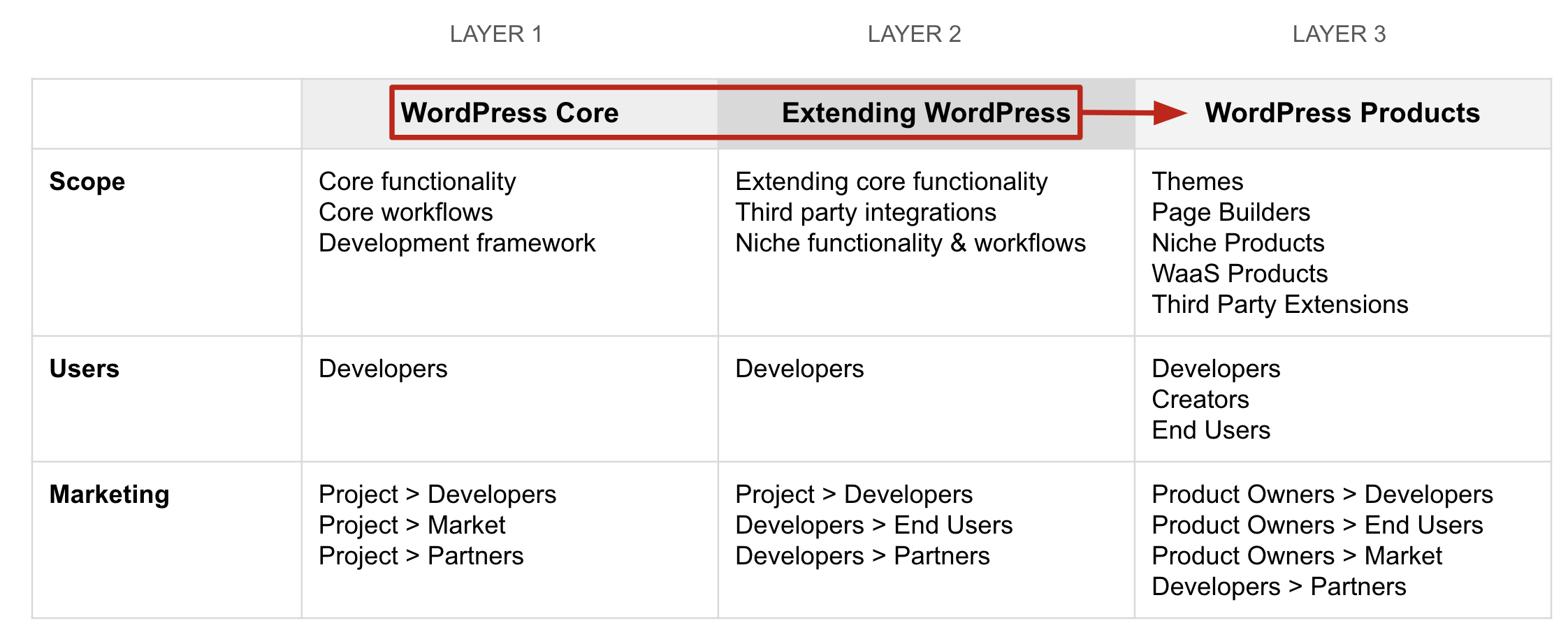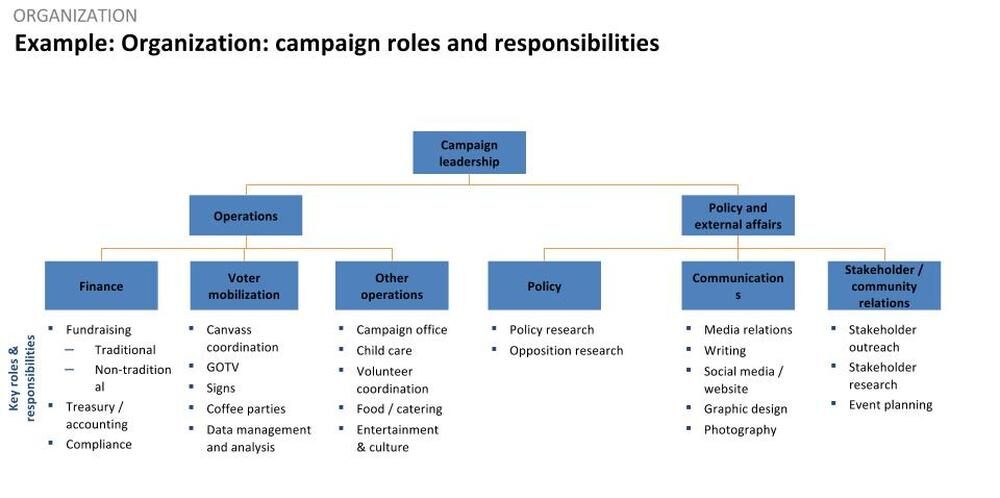There’s been a lot of talk about Marketing WordPress in the last year or so, and some interesting ideas are taking shape. The latest of which were discussed at WordCamp US a few days ago, that included a number of next steps. The concern is that WordPress’ growth has stagnated. Noel Tock, one of the co-founders of Human Made, covered this trend very clearly during his keynote at WordCamp Asia this year – it’s worth a watch.
There are also ideas bouncing around as to how to resource a renewed Marketing function for the project. Dave Grey and Andrew Palmer have set up FundWP to help “secure consistent funding for WordPress,” complementing the Five for the Future Initiative. I think Andrew is also one of a number of people behind the idea to turn the repo into an app store for both free and paid plugins – the project would get a cut from the sale of the latter, and part of the cash could fund Marketing.
A couple of foundational points keep coming up in these discussions too: what is WordPress, who is it for and what is its future. This blog post is my contribution to the discourse. My intention is to inject some fresh ideas, starting with an unpopular one.
WordPress is for developers (and they make it for everyone else)
So, not designers using page builders or ‘makers’ prompting the latest AI to generate a full website. I’m talking about folks that can code plugins and themes in Notepad++ and are developing the tools everyone else uses to build with WordPress. And know React.
WordPress core shouldn’t attempt to be Wix so that about anyone can build a website. It’s a great idea but the complexity needed to make things simple on the front requires large development and product teams, just like Wix has.
Look at Gutenberg and where it’s at now in terms of functionality and UX. And let’s be honest – a 10 year plan to build it is 7 years too long. We need to measure how successful development is by looking at the end result, sure, but also the speed by which goals are achieved.
My view is that WordPress core shouldn’t cater for all – we have page builders and other tools for that. Even WaaS offerings where WordPress isn’t to be seen. That is, a functionality layer on top of core that… democratizes anything you want. This is how WordPress has evolved and I believe it’s the reason for its success. We have a tried and tested model already.
Here’s an attempt to define, at a high level, who WordPress is for, splitting the product into in three ‘layers’:

It’s always useful to represent relationships between products and their users from 10,000 feet. In this case, we’re figuring out who is responsible for Marketing what. Product scope is already well defined – WordPress has 20+ years worth of dev work under its belt. The Marketing side, however, hasn’t been nailed. It’s been more tactical than strategic and we need to work on the latter, taking into account the product layers and how they can support each other.
I agree with Kevin Geary when he says that WordPress should do a better job to support development best practices and workflows – check out his Dear WordPress video. It feels like Gutenberg tried but failed to become a tool for everyone to use. In the meantime other core functions have been neglected. It’s somewhat ironic that Etch, the Blocks-powered dev tool he recently announced, created more of a buzz than Gutenberg ever did, and it hasn’t even been built yet! There were a series of slides covering promised features and each one of them addressed a developer pain point. In contrast, Gutenberg’s features and capabilities have been drip-fed to the community over the years diluting the impact of Marketing the bigger picture. This is also a measure how badly a well-resourced Marketing function is needed. It needs to be a key contributor during the research and planning stages of product development too.
With a much narrow focus than ‘WordPress is for everyone’ everything becomes easier, including Marketing to one segment only. Jamie Marsland, Automattic’s new Head of WordPress YouTube, shared on X the audience he thinks he should produce videos for:
- Beginners and DIY’ers
- Developers
- Designers
- Agencies and Freelancers
- Product Suppliers
- Community
Here’s the problem, and I suspect Jamie will realize this too: there’s a ton of work you need to do for each of these. Messaging, channels, tactics, etc.. are different. If you focus all your attention on one segment only it becomes easier to plan and execute a much more effective Marketing. Also, the developer segment is quite broad as far the type of people you want to reach, from the freelance dev to the CTO of a corporation. Covering a wide range of topics too: the benefits of open source, flexibility, security. etc…
Here’s the kicker. You can still reach other segments and niches via the developers that are building products and services for them. Newspack is an example of this: an Automattic offering powered by Automattic packaged for publishers. You don’t hear much about them within the WordPress bubble but outside if you get press releases such as this one: Everlit Partners with Newspack and Automattic to Revolutionize AI Audio in Newsrooms.
Reposition WordPress as the ‘Operating System for the free web’
Matt Mullenweg’s words, not mine:
What we want to do is to become the operating system for the open web. We want every website, whether it’s e-commerce or anything to be powered by WordPress. And by doing so, we’ll make sure that the web can go back to being more open, more integrated and more user-centric than it would be if proprietary platforms become dominant.
I disagree with a lot of what he says and does but I’m behind this idea 100%. Here’s why:
Competitor platforms are not just content management systems anymore. They offer payment facilities, marketing tools, CRM, etc… everything you need to run a business. Noel Tock talked about this on a recent WP Product Talk live stream:
If you look at a Squarespace or Wix or whatever, they are no not just a website builder anymore, but more a SMB operating system. You do your reservations, you take transactions.
This should sound familiar because you can create pretty much any stack using WordPress. This is the platform’s super power and a USP that needs to be pushed more. For example, The WordPress / WooCommerce combo is not just a tool to create an online store. That’s the starting point – you can build anything you want around it. For example, if you’re a budding entrepreneur and want emulate Redbull’s evolution from a drink brand to a media empire, would you choose Shopify or WooCommerce?
WordPress is more than a CMS and should be positioned as such. I also think that there is a big opportunity beyond the business OS paradigm: to underpin a freer, more open web.
WordPress as an engine for freedom. This idea is a little fuzzy as we interpret ‘freedom’ differently. I like think of it in these terms:
- To allow everyone to have a voice
- To allow everyone to own their own identity and data
- To allow everyone to build something of value
- To prevent closed systems and private entities from preventing #1, #2 and #3
WordPress is facilitating much of this because it’s open source, decentralized and has scale. But it’s not enough. It needs to become a serious threat to Big Tech’s market share. This is the KPI the project and the community should aim for.
How? Through serious innovation. Working with and aligning with emerging technologies in the Web 3.0 space. Being more ambitious with Gutenberg and extend it beyond WordPress core. Just as the Block Protocol promises, and perhaps being part of that initiative.
It’s time to recognize that we have accomplished the the mission to Democratize Publishing and move on to bigger and greater things. Perhaps this can be a new BHAG (Big Hairy Audacious Goal) that we can rally behind?
Marketing WordPress: taking a leaf out of political campaigns
Despite the polarization, following the US presidential election is very interesting. We’re mostly exposed to the top level messaging delivered by the candidates, but behind each there’s a sophisticated campaigning machine. What’s worth looking at, in my opinion, is how key points are being amplified 24/7 across multiple channels, including armies of volunteers.
Before I discuss the model, let’s look a Evo Morales‘ 2005 successful presidential campaign in Bolivia. He was successful despite being the underdog and having access to a fraction of resources. I’ll let Claude AI summerize key aspects of the campaign:
- Indigenous and labor union support: Morales built a strong base among Bolivia’s indigenous majority and labor unions, groups that had historically been marginalized in Bolivian politics.
- Grassroots organizing: The campaign relied heavily on community-level organizing, particularly in rural areas and poor urban neighborhoods.
- Anti-establishment message: Morales positioned himself as an outsider fighting against the traditional political elite and foreign influence, which resonated with many Bolivians.
- Focus on resource nationalism: His promise to nationalize Bolivia’s natural gas industry and use the proceeds to benefit the poor gained widespread support.
- Low-cost, high-impact events: Instead of expensive TV ads, the campaign organized rallies and marches that generated significant media coverage.
- International solidarity: Morales received support from left-wing groups and indigenous rights organizations across Latin America, amplifying his message.
(Please don’t interpret anything as political in this. There are examples of successful right-wing campaigns too. This was the first one Claude AI spat out once I told it not to look at the US. The point I am making is that it’s possible be successful even with limited resources.)
So, how can the above apply to Make WordPress Marketing?
The main driver, I think, is getting everyone excited behind a cause. As I mentioned before, it needs to be a BHAG.
Secondly, you need to organize and mobilize volunteers, which is how Make WordPress Marketing is set up to operate already. But with much more of a focus on higher level messaging and reaching outside the ecosystem. The Media Corps initiative is a good model for this but needs to be extended to work with the broader community (and not just the handful of media properties we all know and love) and a wider scope.
Let’s get back to the US elections and how campaigns are organized. Here’s an org chart from DemocracyKit, a ‘civic campaign resource library’.

This model will not work as is, of course, so I’ll try and update some of the boxes to make it work for the project.
- Campaign Leadership – this is a CMO figure that many believe is a critical role. The project had one – Joost de Valk – back in 2019, but it didn’t work out.
- Operations – you only need the Finance part here
- Policy and External Affairs – replace policy with ‘Marketing’
- Policy – replace with ‘Product Marketing’ and add a number of core ‘child’ functions: Content, SEO and Social Media
- Communications – focusing on PR
- Stakeholder / Community Relations – this is where there current Media Corps belong, along with other stakeholder groups (eg. the Scale Consortium)
A word about events. I think WordCamps and Meetups should be less about chasing net new customers and more about connecting and energizing existing players. They will never be able to attract the volume of new users we need to be make a difference. Instead, they should empower the community to do so.
One final thought about the ‘focus on resource nationalism’ point of the Morales campaign. Matt Mullenweg is right when he says that the bigger players in the ecosystem need to contribute more. I think having a renewed mission and clarity around the what and the how the project aims to achieve it will help.
0.75% for the Future
It’s easy to put ideas on paper without considering resourcing. Who’s going to pay for it all?
Businesses spend anything between 1 and 20% of revenue on Marketing. The project should aim towards the higher mark, say 15%. If this means cutting back on development so be it.
Here are some scary stats. Wix’s revenue last year was $1.562B. If 10% of it is going to Marketing that’s $156M. Some of that is going towards promoting Wix Studio, which is a much more ‘dangerous’ competitor than their main offering as it’s targeting developers too.
There other other ways to raise funds and find resources beyond the Five for the Future initiative. Like the Fund WP idea. Or the one about making the plugin directory more like an app store. What else can we do?
How can we get going? I think that resourcing is the starting point so we know how wide or narrow scope – something we can actually deliver – needs to be. The project can figure out what it needs to do. With help from the community.
Links & Resources
- Make WordPress Marketing
- Is the WordPress Market Share Declining and What to do about it? – WP Product Talk
- It’s Time to Financially Support the WordPress Ecosystem: One Simple Idea – SomebodysHero




Lawrence
The of Social Web Foundation was announced a few days ago, and I think this is an important step towards a more open and freer web.
https://socialwebfoundation.org/2024/09/24/launch/
I think WordPress’s mission should align with this as part of a broadening of its scope beyond ‘Democratizing Publishing’